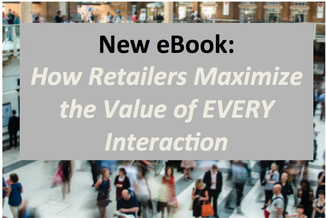Recently, we spoke about the importance of Increasing Customer Lifetime Value. By optimizing offers for each targeted customer segment, you can improve the conversion rates for your best customers and increase their engagement and purchases.
While we mentioned that average revenue per customer (ARPC) or average order value (AOV) isn’t always a valuable indicator, it is still a useful structure for analyzing growth in CLV over time. That value is particularly dependent on the structure of the company and the customer purchase cycle. The value of AOV increases as the average number of purchases per customer per year decreases.
Measuring AOV should be a given in retail. You have to know your customers at the purchase level – who comes in to pick up one thing because you’re convenient vs. who calls you their store of choice. It’s easy to think increasing AOV is the obvious goal, right? Not necessarily. You have to look a layer deeper.
For some organizations with high foot traffic or high purchase frequency, AOV is not a successful indicator of the value of particular customers. Those customers come in all the time, and their value can’t be summed up by a small average order size because, over time, they may be your best customers. On the flip side, for organizations with lower foot traffic or lower purchase frequency, it is more important to maximize the value of each order or purchase. For those organizations, growth in AOV provides insight into improving customer value.
As in all analysis, your data – and the tactics it informs – have to drive back to your strategy. That is, what are your organizational goals, and how are you supporting them?
Target, for example, has a clear focus on increasing AOV. By adding a grocery department to their in-store experience, they’re drawing new customers. Those customers are perhaps entering the store primarily to buy groceries, but over time, the goal is to have them filling their carts with additional items – clothing, home goods, whatever we “need” from the Dollar Spot…
It’s the same reason they put the pharmacy in the center of the store. You have to walk past an array of other products to get there. Adding “convenience” features like grocery and pharmacy is an effort by Target to not only increase the number of trips a customer makes to the store, but to increase their AOV each time.
On the other hand, look at Amazon. They’re also a (digital) one-stop shop, with a robust product offering ranging from convenience and consumables to higher-ticket items and collectibles. The rollout of Prime does absolutely nothing to support filling your cart before you check out. You don’t save anything by bundling your shipping, and the online and mobile checkouts are so easy to use, you can make single purchases all day long. Adding Dash to the mix only escalates the situation. So has Amazon cannibalized their AOV by making checkout and shipping too easy? Yes, but it doesn’t matter. They’ve created a model that shows success simply can’t always be measured by AOV.
AOV has to be considered in light of the overall strategy for the retailer. Either way, the goal is to increase purchases in areas specifically defined by each retailer. In some cases, you look at volume by purchase and in others, you look at volume overall. And it’s crucial that you know the strategy you’re supporting when you design your analysis.
It all has to work together as you’re pulling the different levers. If your departments aren’t running in alignment with the strategy, you’ll have parts of your business optimizing primarily for CLV and other parts optimizing AOV. And if there’s a disconnect, the model falls apart and ultimately, goals aren’t met – organizationally or by department.
Marketers are tasked with understanding the strategy so that all campaigns and metrics feed into it. Those metrics need to be actionable; they need to empower your marketing team to better target, better understand, and better convert your customers.


